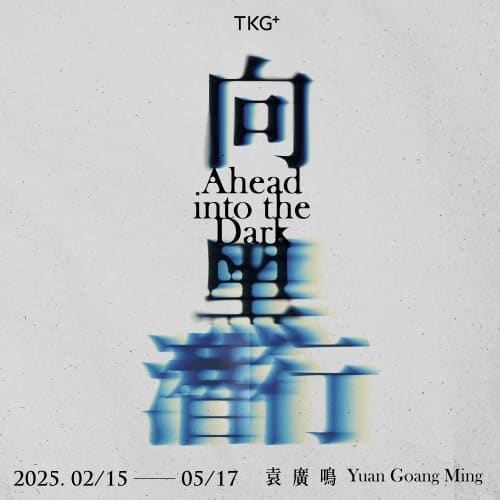Ahead Into the Dark: Yuan Goang-Ming solo exhibition
-
Overview
Dates
02.15–05.17.2025
Reception
02.15.2025 (Sat.) 4:30 p.m.
Venue
TKG+ B1, No. 15, Ln. 548, Ruiguang Rd., Neihu Dist., Taipei , Taiwan
TKG+ is pleased to present Ahead Into the Dark, Yuan Goang-Ming’s 2025 solo exhibition. Ahead Into the Dark presents three new works—Everyday War, The Breathing Black Hole, and Flat World—each emerging from distinct starting points.Connected by the unifying concept of “black,” the exhibition embarks on an interwoven journey, asking: In the obscurity of darkness, do we search for a glimmer of direction in pursuit of the unknown, or are we compelled to tread inevitably into the shadows?
-
In his previous works Towards Light and Towards Darkness (both 2018), Yuan deconstructed the act of viewing through the language of video. In Towards Light, the violent blinding light of nuclear explosion renders viewing futile, while in Towards Darkness, the absence of light allows the senses other than sight to take over. The negation of sight indicates not the suppression of sensory perception, but a reset, breaking away from the habitual dependence on the visual sense and light, shifting instead toward an experience more holistic and intrinsic.
Ahead Into the Dark is a continuation of this process. Light, for the artist, is a metaphor for how technology and power can diminish our sensory experience, while darkness serves not as mere absence of, but a critical response to light, suggesting an alternative way to perceive and understand our world. Drawing on darkness’s associations with fear, vulnerability, and the unknown, the exhibition conjures the image of an individual who, even while engulfed in darkness, persists with determination toward hope.
-
 Everyday War | 2024 | Single-channel video | 10’33''
Everyday War | 2024 | Single-channel video | 10’33''The exhibition opens with Everyday War (2024), a single-channel video depicting a middle-class individual’s studio apartment. In this seemingly orderly domestic scene, invisible forces suddenly intervene — walls crack, furniture topples, and the room instantaneously demolished. Moments later, everything returns to normal as if the catastrophe never occurred. This cyclical narrative blurs the boundaries between life and disaster, reality and fiction, revealing how war seeps into all corners of daily existence. Scenes of shimmering light and crumbling space alternate to evoke an absurd yet authentic tension, suggesting that the surface calm of everyday life may only mask an underlying crisis.
-
 Breathing Black Hole | 1995-2024 | Light-Kinetic Installation (Luminescent Powder.UV light.Motorized Linear Track System) | Dimensions variable
Breathing Black Hole | 1995-2024 | Light-Kinetic Installation (Luminescent Powder.UV light.Motorized Linear Track System) | Dimensions variableThe Breathing Black Hole (1995–2024) expands on The Moving Luminous Square (1995), reimagining the impossible vision of black light as a tangible, rhythmic space. Through the mechanical movement of an aluminum plate coated with luminous powder, a glowing halo on the wall ebbs and flows, breathing with the rhythm of a black hole. Here, black light becomes symbolic, hinting at the absence of light, and the accumulation and release of energy, challenging the viewer’s preconception of darkness. This pulsating darkness not only echoes the physical imagery of a black hole consuming everything, but reveals the dual nature of darkness as a realm of chaos and creation. At the intersection of light and shadow, the viewer’s visual boundaries dissolve, their physical perception reawakened, allowing for an exploration of the root of existence. Darkness is no longer a mere embodiment of emptiness or fear, but a hidden space brimming with power and hope, inviting a deeper engagement with perception and thought within the exhibition.
-
 Flat World | 2024 | Single-channel video | 10’00'' (Image by © DircinhaSW, Avenida Paulista. Courtesy of Getty Images.)
Flat World | 2024 | Single-channel video | 10’00'' (Image by © DircinhaSW, Avenida Paulista. Courtesy of Getty Images.)Flat World (2024) extends into the idea of globalization, exposing the distortion and alienation of modern viewing methods. Using the Google Street View database, the work merges 305 locations into an endless digital journey through fixed linear perspective and steady movement. The shifting landscapes coalesce into an unfolding map, presenting a seamless but clinical aesthetic, while collapsing geographical depth and corporeal presence. The map morphs from a vessel of local memory and legend into a symbol of technology and authority. Viewing devolves into point-to-point jumps, with space and emotion disappearing entirely. The video loop implies the illusion of the globalized order, with continuous street scenes epitomizing the modern technological system, illuminating the paradox of human alienation and displacement. Yuan pushes the concept of the flat world to its extreme, confronting the viewer with the contradiction and ambiguity of technological manipulation through sterile, oppressive imagery.
-
The three works construct a progressive trajectory, with darkness as the central motif that weaves through the crumbling of the familiar, the challenge of perception, and the distortion of globalized viewing. In Everyday War, darkness exemplifies the crisis and disruption within the mundane. In The Breathing Black Hole, it transforms into a primordial field nurturing hope and life. In Flat World, darkness lurks deep within the globalized technological system, denoting the conflicted state of alienation and rootlessness. Yuan’s Ahead Into the Dark not only plumbs the depths of darkness but also, through video and installation, interrogates contemporary existence.
Through a video language that is rigorous and piercing, Yuan Goang-Ming reflects on our present condition, where stability seems an unattainable concept. Moving forward appears to be humanity’s inescapable fate, but what lies ahead? Will it be an expanse of darkness, or a place where hope resides?
-

© TEDxTaipei
-
Artist
-
Publications








